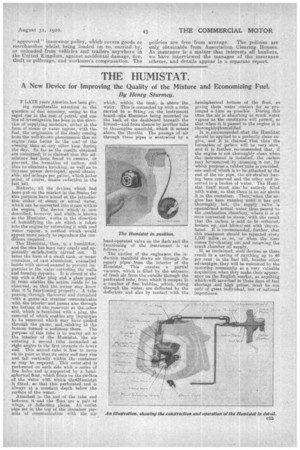THE HUMISTAT.
Page 17

If you've noticed an error in this article please click here to report it so we can fix it.
A New Device for Improving the Quality of the Mixture and Economizing Fuel.
By Henry Sturmey.
F LATE years America has been giv
ing considerable attention to the question of fuel economy, owing to the rapid rise in the cost of petrol, and one line of investigation has been in the direction of supplying moisture, either in the form of steam or water vapour, with the fuel, the origination of the stusly-coming from the well-known phenomenon that an engine runs better in the cool of the evening than at,any other time during the day. So far as the results obtained are concerned, it is claimed that this admixture has been found to remove, or prevent, the formation ,of (Arbon, and thus to eliminate knocking, as well as to increase power developed,speed obtainable, and mileage per galion,, Which latter point, of course; means reduction in -the fuel bill.
Hitherto, all the devices which had been, put on the market in the States for this purpose have aimed at the introduction either of steam or actual water, which can be converted into steam within the engine. The device which is now described, however, and which is known as the Humistat, works in the direction of humidifying the air which is taken into the engine by saturating it with cool water vapour, a method which would appear more nearly to reproduce the conditions required. The Humistat, then, is a humidifier, and the idea has been very neatly and ap
parently satisfactorily carried out. It takes the form of a small tank, or water container, of cast aluminium, enamelled inside with &toyed enamel to prevent impurities in the water corroding the walls and forming deposits. It is closed at the top with a filler plug and a glass panel in front enables the action inside to be obsered, so that the owner may know that it Is functioning properly.. A tube passing through theicover and furnished with a gauze ,air strainer communicates with the interior and passes also through the bottom of the reservoir at the other end, which is furnished with a plug, the removal of which enables any impurities to be removed which may have .passed through the gauze, and,asinking to the bottom formed a sediment: there. The purpose of this tube is to convey air to the interior of the Humistat, the air entering a second tube connected at right angles to the first towards its lower end. This second tube is free to move on its joint, so that.its outer end may rise and fall vertically within the • container as may be req.uit7ed. This outer,end is perforated on each side with a series of fine holes and is supported by a hemispherical float, which floats on the surface of the water with *hick the4Humistat is fitted, so that this perforated e,nd is always at a constant depth below the surface of the water.
Attached to the end of the tube and between it and the float are a pair of wings, or deflecting plates. An outlet pipe set in, the top of the container permits of communication with the .air
which, within the tank; is above the water. This is connected up with a tube carried to a, fitting on the instrument board—the Husnistat being mounted on the back of the dashboard beneath the bonnet—and from thence by another tube to the4engine manifold, which it enters above the throttle. The passage of ..air through these pipes is soatrelled by a
band-operated valve on the dash and the functioning of the instrument is as follows :— The suction of the engine ion the inducti6n manifold draws air through the supply pipesfrom the interior of the Humistat. This creates a partial vacuum, which is filled by the entrance of fresh air from the outside through the perforated tube, from which it-escapes in a number of _fine bubbles, :which, rising through the water, are deflected by the deflectors and also by contact with the hemispherical bottom of the float, so giving them water contact for as prolonged a. time as possible. During this time the air is absorbing as much water vapour as the conditions will permit, so thatwhen it is passed to the engine it is thoroughlythumidified. It is recommended/that the Humistat should be applied to a perfectly clean engine, and it is claimed that then the formation, of earbon will be very slow, and it is further, recommended that, if the engine is not thoroughly clean when the instrument is installed; the carbon may. bOretrioved by steaming it out, for which purpose a rubber tube is provided, one sachet which is to be attached to the end of the air pipe, the air-strainer having been removed and the other end inserted in a bucket of water. The Humistat itself must also be entirely filled with water, so that there is no air above it in the container. Then/when the engine has been running until it has got thoroughly hot, the supply valve is openediatiel actual water thus.passed to the combustion chambers, where it is at once converted to steam, with. the result
that the carbon is said to softened, broken up, and blawn,'out with the exhaust. It is recommended, further, that this treatment should be repeated every 1,000 miles, or so, or when the time comes fonclearing out and renewing the crank chamber oil supply. If, as issclaimed, such devices as these result in a saying of anything up to 40 per cent , in the fuel bill, besides other advantages, they will be welcomed by the motoring. community as a very valuable acquisition when they make their appear. a,nee on the English market, as anything whichiwill save,fuel in these days of fuel shortage and high prices, must be not only of great individual, but of national importance:




























